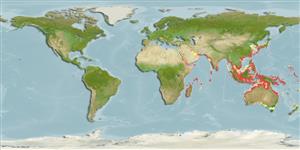Common names from other countries
Teleostei (teleosts) >
Gobiiformes (Gobies) >
Gobiidae (Gobies) > Amblyopinae
Etymology: Trypauchen: Greek trypa meaning hole and auchen for neck (Ref. 58767).
More on authors: Bloch & Schneider.
Environment: milieu / climate zone / depth range / distribution range
Ecology
Marine; brackish; demersal; amphidromous (Ref. 51243). Tropical
Indo-Pacific: Coasts of India through the Malay Archipelago to China; in the Philippines (Ref. 280); also reported from New Caledonia (Ref. 5525). Reported from South Africa (Ref. 7050).
Length at first maturity / Size / Weight / Age
Maturity: Lm 16.6 range ? - ? cm
Max length : 22.0 cm TL male/unsexed; (Ref. 4833)
Distinguished by the following: total elements in dorsal fin 50-58; total elements in anal fin 43-50; pectoral-fin rays 15-20; anal-fin pterygiophores preceding the first hemal spine 3-4; caudal
vertebral count 23-24; SL/total length 0.815-0.938; head length/SL 0.161-0.179; predorsal length/SL 0.188-0.218; prepelvic length/SL 0.157-0.175; preanal length/SL 0.308-0.362; four to 16 teeth on outer row of upper jaw; 8-13 teeth on outer row of lower jaw; longitudinal scale rows 69-98 (Ref. 058767).
Common in most coastal zones (Ref. 4833). Occurs along the bottom in tidal rivers and estuaries. Stays close to a self-dug burrow. Sometimes marketed fresh (Ref. 12693).
Life cycle and mating behavior
Maturities | Reproduction | Spawnings | Egg(s) | Fecundities | Larvae
Talwar, P.K. and A.G. Jhingran, 1991. Inland fishes of India and adjacent countries. Volume 2. A.A. Balkema, Rotterdam, i-xxii + 543-1158, 1 pl. (Ref. 4833)
IUCN Red List Status (Ref. 130435)
CITES (Ref. 128078)
Not Evaluated
Threat to humans
Harmless
Human uses
Fisheries: minor commercial
Tools
Special reports
Download XML
Internet sources
Estimates based on models
Preferred temperature (Ref.
115969): 23.9 - 29.1, mean 28.2 (based on 1416 cells).
Phylogenetic diversity index (Ref.
82804): PD
50 = 0.7500 [Uniqueness, from 0.5 = low to 2.0 = high].
Bayesian length-weight: a=0.00437 (0.00343 - 0.00556), b=2.97 (2.90 - 3.04), in cm Total Length, based on LWR estimates for this species (Ref.
93245).
Trophic level (Ref.
69278): 3.5 ±0.50 se; based on food items.
Resilience (Ref.
120179): High, minimum population doubling time less than 15 months (Preliminary K or Fecundity.).
Fishing Vulnerability (Ref.
59153): Low vulnerability (24 of 100).
